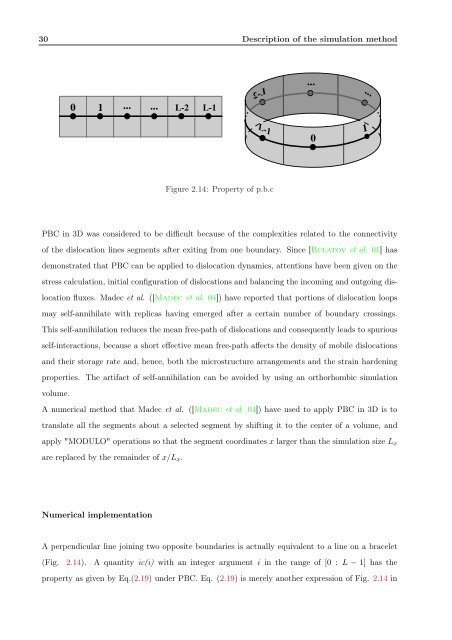3D DISCRETE DISLOCATION DYNAMICS APPLIED TO ... - NUMODIS
3D DISCRETE DISLOCATION DYNAMICS APPLIED TO ... - NUMODIS
3D DISCRETE DISLOCATION DYNAMICS APPLIED TO ... - NUMODIS
Create successful ePaper yourself
Turn your PDF publications into a flip-book with our unique Google optimized e-Paper software.
30 Description of the simulation method<br />
0 1 ... ... L-2 L-1<br />
L-1<br />
Figure 2.14: Property of p.b.c<br />
PBC in <strong>3D</strong> was considered to be difficult because of the complexities related to the connectivity<br />
of the dislocation lines segments after exiting from one boundary. Since [Bulatov et al. 01] has<br />
demonstrated that PBC can be applied to dislocation dynamics, attentions have been given on the<br />
stress calculation, initial configuration of dislocations and balancing the incoming and outgoing dis-<br />
location fluxes. Madec et al. ([Madec et al. 04]) have reported that portions of dislocation loops<br />
may self-annihilate with replicas having emerged after a certain number of boundary crossings.<br />
This self-annihilation reduces the mean free-path of dislocations and consequently leads to spurious<br />
self-interactions, because a short effective mean free-path affects the density of mobile dislocations<br />
and their storage rate and, hence, both the microstructure arrangements and the strain hardening<br />
properties. The artifact of self-annihilation can be avoided by using an orthorhombic simulation<br />
volume.<br />
A numerical method that Madec et al. ([Madec et al. 04]) have used to apply PBC in <strong>3D</strong> is to<br />
translate all the segments about a selected segment by shifting it to the center of a volume, and<br />
apply "MODULO" operations so that the segment coordinates x larger than the simulation size Lx<br />
are replaced by the remainder of x/Lx.<br />
Numerical implementation<br />
A perpendicular line joining two opposite boundaries is actually equivalent to a line on a bracelet<br />
(Fig. 2.14). A quantity ic(i) with an integer argument i in the range of [0 : L − 1] has the<br />
property as given by Eq.(2.19) under PBC. Eq. (2.19) is merely another expression of Fig. 2.14 in<br />
L-2<br />
...<br />
0<br />
...<br />
1


